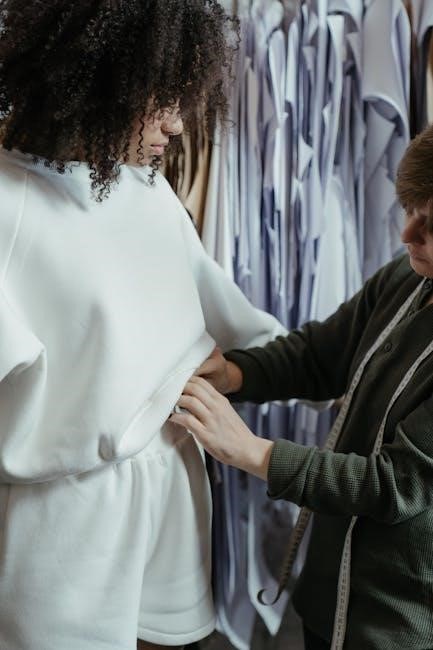Taking accurate dress measurements ensures a perfect fit, boosting confidence and comfort. Learn how to measure bust, waist, and hips using a flexible tape measure for ideal sizing.
Why Accurate Measurements Are Important
Accurate measurements are crucial for ensuring a dress fits perfectly, enhancing both comfort and appearance. They guide the selection of the correct size from size charts, especially when shopping online or for custom-made dresses. Precise measurements help tailors make necessary alterations, ensuring the dress flatters your body shape. They also reduce the risk of purchasing ill-fitting garments, saving time and money by minimizing returns and exchanges. Overall, accurate measurements eliminate guesswork, leading to a more satisfying and efficient shopping experience.
Understanding Standard Dress Size Charts
Standard dress size charts provide a reference for matching body measurements to garment sizes. They typically include bust, waist, and hip measurements, helping customers choose the right fit. Sizes can vary between brands and regions, so comparing measurements to the chart is essential. To use a size chart effectively, measure yourself accurately over tight-fitting clothing or underwear. Flexible tape measures ensure precise results. While charts are standardized, differences in fit preferences (e.g., slim-fit vs. loose-fit) may exist. Understanding these charts reduces the likelihood of sizing errors, making online shopping more reliable and efficient for all body types and styles.

How to Take Your Measurements
Use a flexible tape measure to accurately measure your bust, waist, and hips over tight-fitting clothing for precise sizing and the best fit.
Essential Tools You Will Need
To take accurate dress measurements, you’ll need a few simple tools. A flexible tape measure is the most crucial item, as it allows you to measure around curves. Ensure it’s at least 36 inches long for full coverage. Wear form-fitting clothing or undergarments to get precise results. A full-length mirror is helpful to see where the tape measure is placed. Keep a notebook and pen handy to record your measurements. For measuring flat garments, a clean, flat surface like a table or countertop is ideal. These tools will help you achieve accurate measurements for the best fit.
Step-by-Step Guide to Measuring Your Body
Start by standing upright and relaxed. Wrap the tape measure around your natural waistline, keeping it level and parallel to the floor. Note the measurement.
For the bust, place the tape measure around the fullest part of your chest, ensuring it’s not too tight or loose. Keep your arms down for accuracy.
Measure your hips by placing the tape measure around the widest part of your hips and buttocks, usually 7-9 inches below your waistline.
Use a mirror to check the tape measure’s position for accuracy. Record all measurements to compare with size charts later.
Tips for Taking Accurate Measurements
- Wear a form-fitting undergarment or clothing to ensure smooth, accurate measurements.
- Use a flexible tape measure and avoid pulling it too tight or leaving it too loose.
- Stand upright and relaxed, with your feet hip-width apart, to maintain natural posture.
- Measure in front of a mirror to visually confirm the tape measure’s position and alignment.
- Take measurements multiple times to verify consistency and accuracy.
- Record your measurements carefully to avoid errors when comparing to size charts.
- Measure at the same time of day, as body measurements can vary slightly throughout the day.

Understanding Your Body Shape
Identify your body type—hourglass, pear, rectangular, or inverted triangle—to determine which dress styles will flatter your figure and create a balanced silhouette naturally.
Common Body Types and Their Characteristics
Understanding your body shape is crucial for selecting flattering dresses. The four main types are:
– Hourglass: Balanced bust, waist, and hips, with a defined waistline.
– Pear: Larger hips and thighs, with a smaller bust and waist.
– Rectangular: Similar measurements across bust, waist, and hips.
– Apple: Fuller midsection, with slimmer limbs.
Each type has unique features that influence how dresses fit. Knowing your body type helps you choose styles that enhance your natural proportions and create a balanced look. This understanding is essential for making informed fashion choices and ensuring a flattering fit in any dress style you choose. Accurate measurements and awareness of your shape are key to achieving this. Use this knowledge to guide your wardrobe decisions for a confident, polished appearance.
How Body Shape Impacts Dress Fit
Your body shape significantly influences how dresses fit and flatter your figure. For example, hourglass figures look stunning in fitted, waist-cinching styles, while pear-shaped individuals benefit from A-line dresses that skim over hips. Rectangular body types can add curves with ruffled or belted designs, and apple-shaped individuals find comfort in empire-waist dresses that draw attention away from the midsection. Understanding how fabric drapes and styles accentuate or balance your silhouette ensures a flattering fit. Tailoring your choices to your body type enhances confidence and creates a polished, personalized look. This knowledge is vital for making wardrobe decisions that celebrate your unique shape and proportions.

Dress Measurements for Different Styles
Measurements vary by dress style: Bodycon dresses require precise body measurements for a snug fit, while A-Line and Loose-Fit dresses focus on bust, hip, and overall proportions.
Measuring for Bodycon and Fitted Dresses
For bodycon and fitted dresses, precise measurements are crucial. Start with your bust, waist, and hip measurements, ensuring the tape measure is snug but not tight. Pay attention to your natural waistline, as this is key for fitted styles. Additionally, measure the length from your shoulders to hem for dresses with a defined silhouette. To ensure accuracy, wear tight-fitting clothing or undergarments while measuring. Double-check your measurements to avoid sizing errors, as these styles require a flawless fit. Proper alignment of the tape measure is essential to achieve a seamless look in body-hugging designs.
Measuring for A-Line and Loose-Fit Dresses
For A-line and loose-fit dresses, focus on key measurements while allowing for ease. Measure bust, waist, and hips as usual, but consider the desired looseness. The bust measurement determines the fit across the chest, while the waist measurement should be comfortable. Hips are measured at the widest point, ensuring the dress flares appropriately. Unlike fitted styles, A-line dresses don’t require extreme precision, as they naturally skim the body. However, ensure the shoulders and neckline fit well for balance. Using a slightly longer tape measure can help maintain the relaxed silhouette without compromising comfort or style. This approach ensures a flattering yet comfortable fit.

Selecting the Right Size
Compare your measurements with size charts to find the best fit. Ensure accuracy by matching bust, waist, and hip numbers for optimal comfort and style.
Using Your Measurements to Choose the Best Fit
Once you have your measurements, compare them to the size chart provided by the retailer or brand. Focus on your bust, waist, and hip measurements, as these are the primary indicators of fit. If your measurements fall between sizes, consider your body type and the dress style. For example, if your hips suggest a medium but your waist suggests a large, opt for the larger size to ensure comfort. Adjustments can often be made for length or sleeve fit. Always double-check the sizing guide for specific styles, as some dresses may run smaller or larger than standard charts. Accurate comparisons ensure the best fit and confidence in your choice.

How to Compare Your Measurements to Size Charts
To compare your measurements to size charts, align your bust, waist, and hip measurements with the corresponding columns. Most charts list sizes alongside these key measurements, allowing you to identify the best fit. If your measurements fall between sizes, consider your body type and the dress style. For example, a fitted dress may require sizing up for comfort, while an A-line dress offers more flexibility. Always check the chart’s units and verify if it’s based on body or garment measurements. Some charts include additional details like inseam or sleeve length, which can further refine your fit. Consistency in measurement taking ensures accurate comparisons.

Common Fit Issues and Solutions
Resolve fit issues by adjusting measurements or sizing choices. If measurements fall between sizes, opt for the larger size for comfort. Alter hems or sleeves as needed.
What to Do If Your Measurements Fall Between Sizes
If your measurements fall between sizes, choose the larger size for comfort and ease. Consider alterations to tailor the fit to your body. Compare your measurements to the size chart carefully, noting any discrepancies. If unsure, consult customer service or use online size guides for guidance. Some brands offer flexible sizing or adjustable features. Double-check the garment’s stretch and fabric type, as this can impact fit. Opting for a slightly larger size ensures mobility, while a smaller size might restrict movement. Prioritize comfort and functionality based on the dress style and intended use. Adjustments can often be made post-purchase for a personalized fit.
How to Adjust for Length, Sleeve, and Neckline Fit
To ensure a perfect fit, compare your measurements to the dress specifications. For length, measure from the shoulder or neckline to your desired hemline. Sleeve adjustments involve measuring from the shoulder to wrist for accurate fit. Neckline fit requires ensuring comfort and proper alignment. If alterations are needed, mark adjustments clearly. Use a flexible tape measure to check for ease of movement. Consult a tailor for professional modifications. Consider fabric stretch and style when making adjustments. Proper fit enhances both comfort and appearance, ensuring the dress flatters your body shape. Adjustments may vary based on dress design and personal preference. Achieve a tailored look with precise alterations.
Accurate measurements and proper fit ensure confidence and comfort. Use this guide to make informed choices, enhancing your wardrobe with dresses tailored to your unique body shape.
Final Tips for Ensuring a Perfect Fit
To achieve a flawless fit, always measure over snug, form-fitting clothing for accuracy. Use a flexible tape measure at least 36 inches long for consistent results. Compare your measurements to size charts carefully, ensuring alignment with your body type. Consider the style of the dress—fitted styles may require sizing up for comfort. Double-check your measurements and consult a second opinion if unsure. For online shopping, use reverse image search to find original listings with detailed size guides. Remember, accuracy and patience are key to finding your perfect fit and embracing your unique style with confidence.
Additional Resources for Further Guidance
For further assistance, explore online resources like Google’s advanced search for detailed sizing guides. Sewing communities and fashion blogs often provide visual tutorials and tips. YouTube offers video guides for measuring techniques. Utilize Google’s unit conversion tool for international size comparisons. Check retailer websites for specific size charts. Use filters to find recent, relevant content. Refer to sewing patterns for professional measurement practices. Visit forums like Reddit for real-user experiences. Ensure accuracy by cross-referencing multiple sources. These tools will enhance your understanding and confidence in achieving the perfect fit. Happy measuring and shopping!

Leave a Reply
You must be logged in to post a comment.